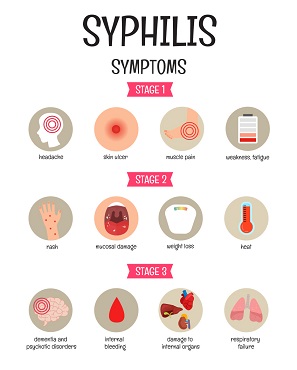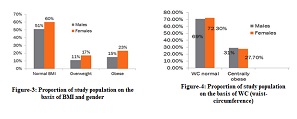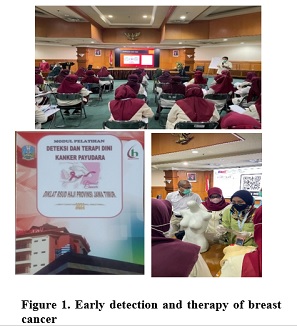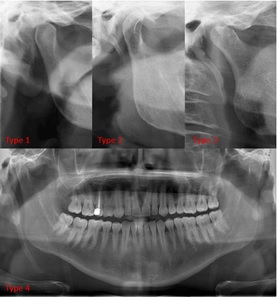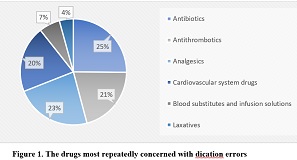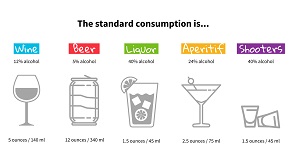Characteristics of Hearing Impairment in Patients with Suspected Congenital Rubella Syndrome at the ENT Clinic of Prof. Dr. I.G.N.G Ngoerah Hospital Denpasar, Indonesia

Asymptomatic rubella virus infection can cause delays in the diagnosis of rubella in pregnant women, leading to the development of congenital rubella syndrome (CRS). The clinical manifestations of congenital rubella syndrome are called the rubella triad, which includes heart problems, eye problems, and hearing disorders. Sensorineural hearing loss is the most common type of hearing loss in children with rubella infection. This study aimed to determine the characteristics of hearing loss in CRS patients. This study used a retrospective descriptive research design, utilizing secondary data from the medical records of patients with CRS who underwent hearing examinations at the Ear, Nose, Throat (ENT) Polyclinic of Prof. dr. I.G.N.G. Ngoerah Hospital Denpasar, Indonesia. The study found that the most common age group among suspected CRS patients was 6 - 12 months (51.42%), the majority of these patients were male (62.86%), the most frequent clinical signs and symptoms in suspected CRS patients were congenital heart disease (CHD) as a major criterion (60%), and microcephaly as a minor criterion (77.14%). Based on the CRS case criteria, none of the suspected CRS patients were diagnosed with confirmed CRS, with most cases being classified as clinical CRS (65.71%). The hearing loss in suspected CRS patients was entirely sensorineural type with the majority of cases being bilaterally and to a very severe degree (53.57%)
1. INTRODUCTION
Rubella is a contagious RNA virus infection and there is no specific treatment for this infection. In 2016, there were 22,361 cases reported worldwide11. A survey conducted in Indonesia from 2010 to 2015 estimated that there were 30,436 cases of rubella. Surveillance data over the last five years shows that 70% of rubella cases occurred in the <15-year age group. Additionally, a study on the estimated burden of congenital rubella syndrome (CRS) in Indonesia in 2013 estimated 2,767 cases of CRS, with an incidence of 82 per 100,000 among mothers aged 15-19 years and decreasing to 47 per 100,000 among mothers aged 40-44 years11. Rubella infection during pregnancy can lead to miscarriage, stillbirth, and CRS in neonates, especially during the first trimester of pregnancy11.
Asymptomatic rubella virus infection can delay the detection of the virus in pregnant women, which may lead to CRS. The clinical manifestations of CRS known as the rubella triad, include heart defects, eye problems, and hearing disorders22. Sensorineural deafness is the most common type of hearing loss in children with rubella infection33. Parents often realize that their child has congenital deafness when the child is older, typically between 2-5 years of age, as growth and development, particularly speech and language abilities, may seem normal in the early years44. Children with congenital deafness may experience speech delays, language disorders, social behavior deviations, and decreased cognitive abilities55.
The incidence of congenital bilateral sensorineural hearing loss in Indonesia is 1–3 per 1,000 births in the normal baby care population and 2–4 per 100 babies in intensive care. In West Java, with a population of approximately 37 million and a population growth rate of 1.8% per year, it is estimated that at least 600 babies will be born with severe bilateral sensorineural hearing loss each year66.
In developing countries, early detection of hearing loss is not yet fully optimized7-9789. Early detection is crucial, particularly in children with risk factors for hearing loss, as 50% of newborns with these risk factors experience hearing loss from birth. Hearing disorders in children can be detected through subjective audiological examination, which involves observing the child's behavioral response to sounds, or through objective examinations such as Brainstem Evoked Response Audiometry (BERA) and Otoacoustic Emission (OAE)44. Given the high number of CRS cases and the public's limited awareness of hearing loss associated with CRS, the authors conducted a study on the characteristics of hearing loss in patients with suspected congenital rubella syndrome at the ENT clinic at Prof. dr. I.G.N.G. Ngoerah Hospital in Denpasar.
2. MATERIALS AND METHOD
This study used a retrospective descriptive research design, utilizing secondary data from medical records of patients with suspected CRS who underwent hearing examinations at the ENT clinic of Prof. dr. I.G.N.G. Ngoerah Hospital, Denpasar, during the period January to December 2018. The research samples consisted of patients with suspected CRS who underwent hearing examinations at the ENT clinic, Prof. dr. I.G.N.G. Ngoerah Hospital, Denpasar in January – December 2018. Ethical clearance for this research was obtained from the Research Ethics Commission No. 1119/UN14.2.2.VII.14/LT/2020 of the Prof. dr. I.G.N.G. Ngoerah Hospital.
Sampling was conducted using the total sampling method, where all data from medical records that met the study's criteria were included in the analysis. The inclusion criteria for this study were all patients with suspected CRS who underwent hearing examination, while the exclusion criteria included patients with suspected CRS who had incomplete medical record data, patients with external and middle ear abnormalities, and patients who had not completed all CRS surveillance examinations.
3. RESULTS
Sample selection was conducted using the total sampling method, resulting in 35 samples. Based on age, the majority of patients with suspected CRS were examined at 6 - 12 months of age, accounting for 18 patients (51.42%), followed by 12 - 18 months with 11 patients (31.42%) and 18 - 24 months with 6 patients (17.16%). Among the 35 research samples, 22 patients (62.86%) were male and 13 patients (37.14%) were female. The sample characteristics are presented in Table 1.
| Variables | Total | Percentage (%) |
Age | ||
<6 | 0 | 0 |
6 – 12 | 18 | 51.42 |
>12 – 18 | 11 | 31.42 |
>18 – 24 | 6 | 17.16 |
>24 | 0 | 0 |
Sex | ||
Male | 22 | 62.86 |
Female | 13 | 37.14 |
Based on the clinical signs and symptoms of CRS, the samples were grouped according to the presence or absence of symptoms and signs. Major criteria included cataracts, congenital glaucoma, congenital heart disease, and retinal pigmentation. Minor criteria included purpura, splenomegaly, jaundice, microcephaly, mental retardation, meningoencephalitis, and radiolucent bone disease. As shown in Table 2, congenital heart disease (CHD) was the most common clinical sign and symptom according to the major criteria, found in 21 samples (60%). In terms of minor criteria, microcephaly was the most frequently observed present in 27 (77.14%) samples.
Clinical signs and symptoms | Yes | No | Total |
Major Criteria Congenital Cataract Congenital Glaucoma Congenital heart Disease Retinal Pigmentation | 11 (31.42%) 0 (0%) 21 (60%) 0 (0%) | 24 (68.57%) 35 (100%) 14 (40%) 35 (100%) | 35 (100%) 35 (100%) 35 (100%) 35 (100%) |
Minor criteria Microcephaly Jaundice<24 jam Purpura Splenomegaly Mental retardation Meningoencephalitis Radioluscent Bone Disease | 27 (77.14%) |
Ministry of Health, Republic Health. Pedoman Surveilans Congenital Rubella Syndrome (CRS). 2018; 15-18 https://www.kemkes.go.id/id/profil-kesehatan-indonesia-2018
Banatvala,J.E, and D.W.G Brown.2014. Seminar Rubela.The Lancet.Vol 363: 1127- 1137. DOI: 10.1016/S0140-6736(04)15897-2
Dammeyer, Jesper. 2020.Congenital Rubela Syndrome and Manifestations. International Journal of Pediatrics Otorhinolaryngology. Vol 74 : 1067-1070 DOI: 10.1016/j.ijporl.2010.06.007
Smith,J.H. Richard,James F.Bale,Karl R. White.2015. Sensorineural Hearing Loss in Children. The Lancet. Vol 365: 879-90.
DOI: 10.1016/S0140-6736(05)71047-3
Moeller,Mary Pat.2020. Early Intervention and Language Development in Children Who Are Deaf and Hard of Hearing. PEDIATRICS official journal of the American Academy of Pediatrics. Vol 106 DOI: 10.1542/peds.106.3.e43
Ezike E, Steele RW, 2013. Pediatric Rubella. Available from URL: https://emedicine.medscape.com/article/968523-overview?form=fpf
Lee, J.Y., Bowden D.S (2020) Rubella virus replicationsand links to teratogenicity. Clinical Microbioloy Reviews 13 (4):571-587. DOI: 10.1128/CMR.13.4.571
Al-Kandari JM, Alshuaib WB, Joe M. BERA in children with hearing loss and delayed speech. Electromyography and Clinical Neurophysiology. 2006 Jan-Feb;46(1):43-49. PMID: 16607866. https://europepmc.org/article/med/16607866
Kadek, Darmadi S, 2017. Gejala Rubela Kongenital (Kongenital) berdasarkan Pemeriksaan Serologis dan RNA Virus [ongenital Rubella Syndrome Based on Serologic and RNA Virus Examination]. Indonesian Journal of Clinical Pathology and Medical Laboratory :13(2):63-71. DOI: 10.24293/ijcpml.v13i2.885
Nguyen TV, Pham VH, Abe K, 2015. Pathogenesis of congenital rubella virus infection in human fetuses: viral infection in the ciliary body could play an important role in cataractogenesis. EbioMedicine, 2: 59–63. https://www.thelancet.com/journals/ebiom/article/PIIS2352-3964(14)00023-1/fulltext
Quintana EM, Solórzano CC, Torner N, González FR, 2015. Congenital rubella syndrome: a matter of concern. Pan American Journal of Public Health, 37 (3): 179- 186. https://pubmed.ncbi.nlm.nih.gov/25988255/
Giambi C, Filia A, Rota MC, Manso MD, Declich S, Nacca1 G, Rizzuto E, Bella A, 2014. Congenital rubella still a public health problem in Italy: analysis of national surveillance data from 2005 to 2013. DOI: 10.2807/1560-7917.es2015.20.16.21103
Psarommatis IM, Goritsa E, Douniadakis D, Tsakanikos M, Kontrogianni AD. Apastolopoulos N. Hearing Loss in Speech-Language Delayed Children. Journal of Paediatric Otorhinolaryngology. 2011; 58: 205-10. DOI: 10.1016/s0165-5876(01)00430-x
Johnson KC. Audiologic Assessment of Children with Suspected Hearing Losing. Otolaryngol Clin N Am. 2012; 35: 711-32. DOI: 10.1016/s0030-6665(02)00060-9
Dewi YA, Agustian RA. Karakteristik gangguan dengar sensorineural kongenital pada anak yang dideteksi dengan brainstem evoked response audiometry [Characteristic of Congenital Bilateral Sensorineural Hearing Loss in
Children Diagnosed by Brain Evoked Response Audiometry]. MKB. 2011;43:77-82. DOI: 10.15395/mkb.v43n2.47
Tian C, Ali SA and Weitkamp JH, 2010. Congenital Infections, Part I: Cytomegalovirus, Rubella and Herpes simplex. Neoroviews 11(8):e436-45. DOI: 10.1542/neo.11-8-e436
Abbas L., Rivolta M. N. (2019). The use of animal models to study cell transplantation in neuropathic hearing loss. Hear. Res. 377, 72–87. DOI: 10.1016/j.heares.2019.03.014
Nomura Y, Kurata T, Saito K. Cochlear changes after herpes simplex virus infection. Acta Otolaryngol 1985; 99: 419–427 DOI: 10.3109/00016488509108933
Luts H, Desloovere C, Wouters J. Clinical application of dichotic multiple-stimulus auditory steady-state responses in high-risk newborns and young children. Audiol Neurootol. 2006;11(1):24–37. DOI: 10.1159/000088852
Urfali S, Urfali B, Sarac ET, Koyuncu O. Safety and Complications of Sedation Anesthesia during Pediatric Auditory Brainstem Response Testing. ORL J Otorhinolaryngol Relat Spec. 2022;84(3):188-192 DOI: 10.1159/000517156
Copyright (c) 2024 I Gede Wahyu Adi Raditya, I Made Wiranadha

This work is licensed under a Creative Commons Attribution-ShareAlike 4.0 International License.
- The journal allows the author to hold the copyright of the article without restrictions.
- The journal allows the author(s) to retain publishing rights without restrictions.
- The legal formal aspect of journal publication accessibility refers to Creative Commons Attribution Share-Alike (CC BY-SA).
- The Creative Commons Attribution Share-Alike (CC BY-SA) license allows re-distribution and re-use of a licensed work on the conditions that the creator is appropriately credited and that any derivative work is made available under "the same, similar or a compatible license”. Other than the conditions mentioned above, the editorial board is not responsible for copyright violation.























